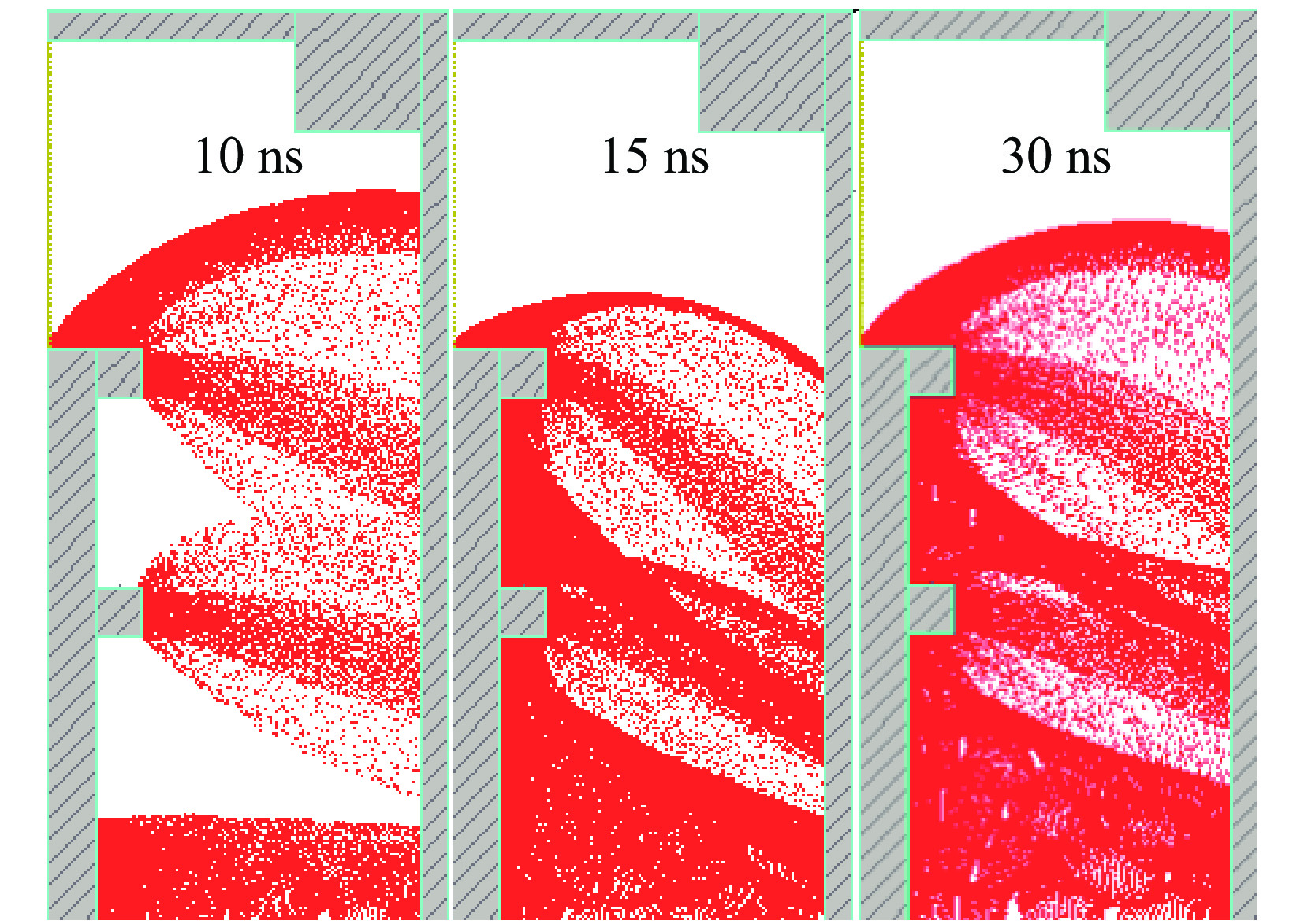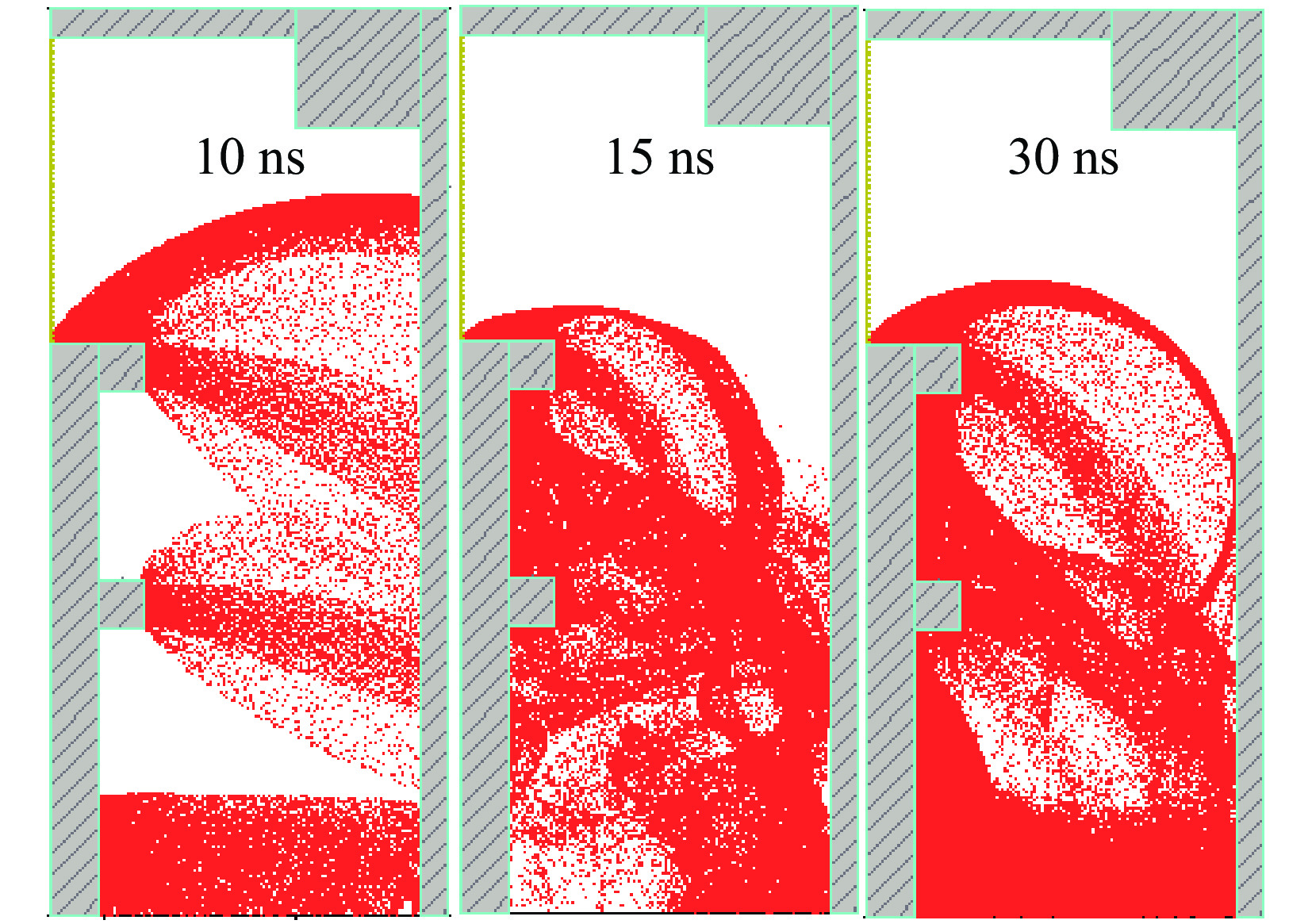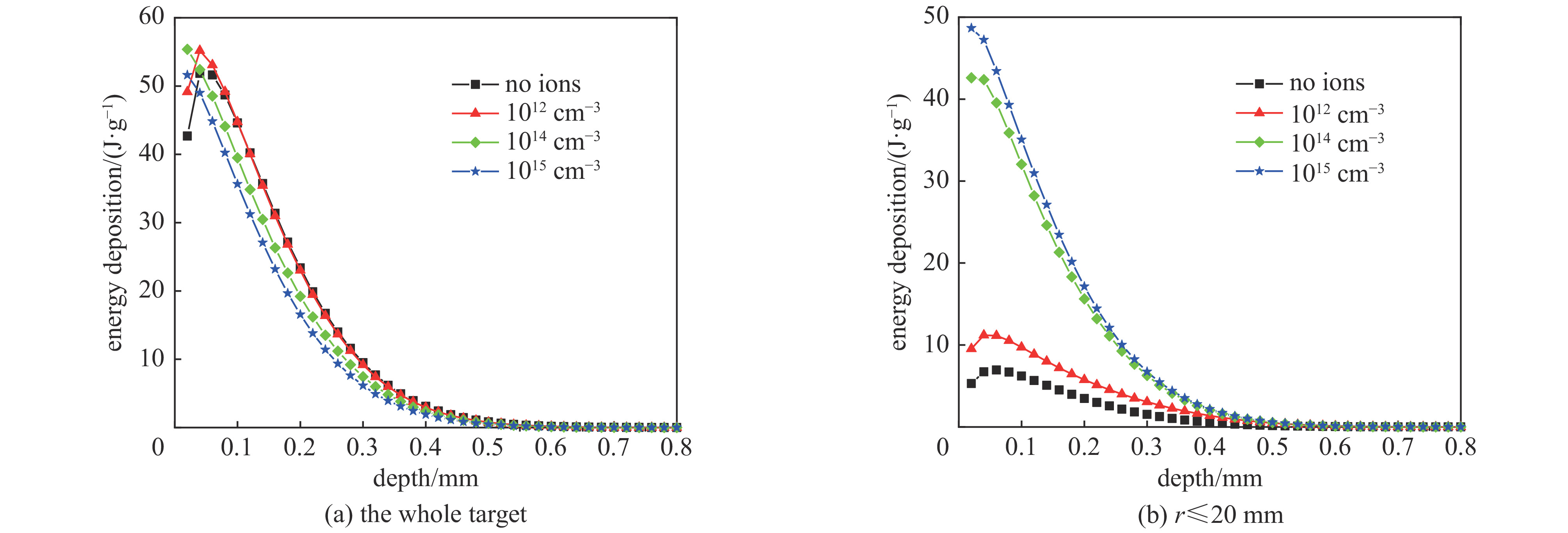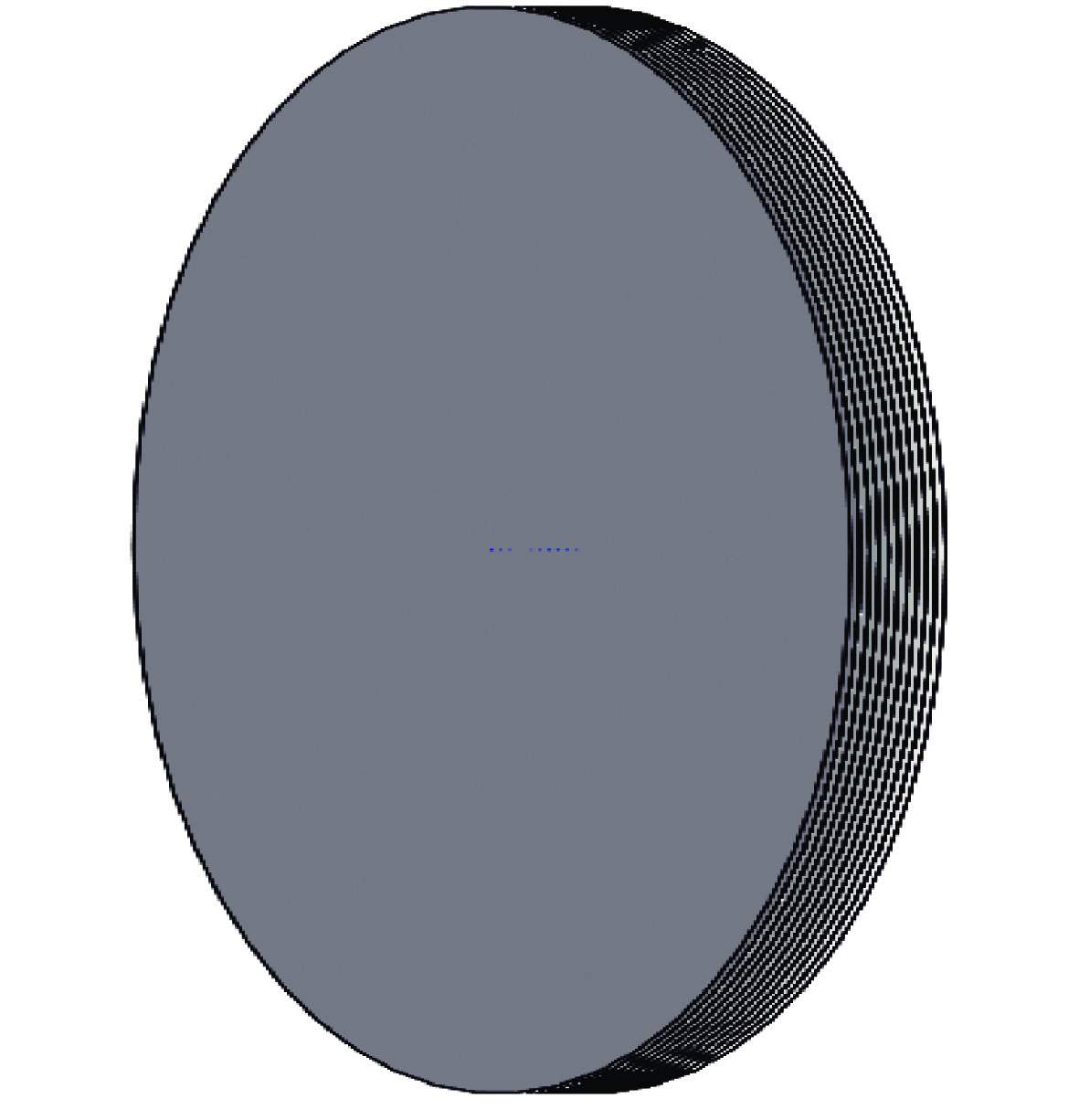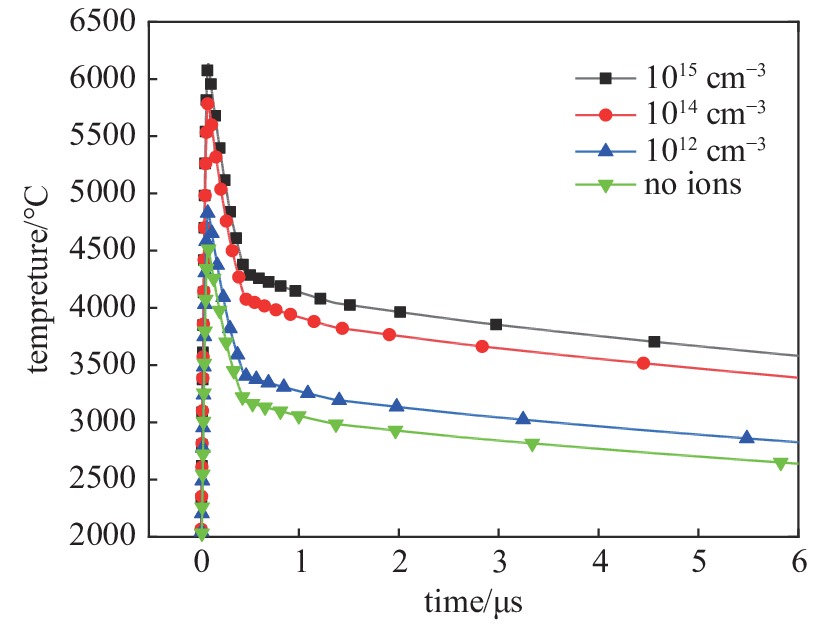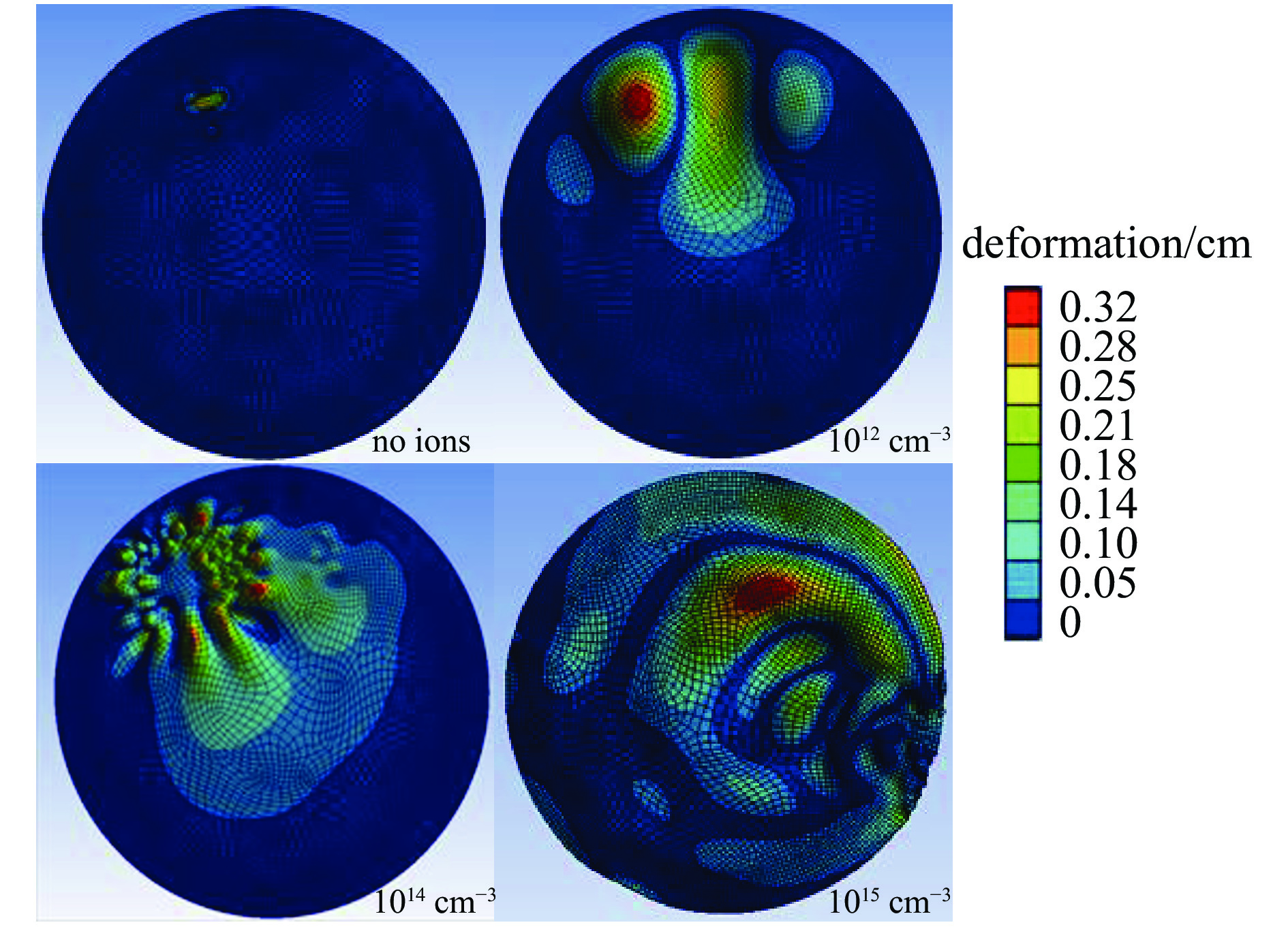Simulation of the temperature and thermal deformation of anode targets in high-current diodes
-
摘要: 以电子束在靶中的能量沉积剖面为桥梁,建立了二极管阳极靶温度和热形变模拟方法。该方法可获知二极管不同工作状态下靶的温度分布和热形变情况,为靶热-力学损伤研究提供基础数据,为二极管构型设计和寿命提升提供技术支撑。将该方法应用于“强光一号”短γ二极管,计算结果显示:当阳极离子密度大于1014 cm−3时(强箍缩),靶表面温度最高可达5500~6000 ℃,热形变量达约4.5 mm;无离子流时(弱箍缩),温度处在4500 ℃左右,形变为2.8~3.5 mm。Abstract: The thermal-mechanical damage induced by high current pulsed electron beam striking on anode targets is a key factor affecting the stability and lifetime of high current diodes. This problem is mostly addressed by replacing the anode target and cleaning the cavity and cathode to ensure the normal operation of the diode. In this paper, a diode anode target temperature and thermal deformation simulation method is established using the energy deposition profile of the electron beam in the target as a bridge. The method can be used to determine the temperature distribution and thermal deformation of the target under various diode operating conditions, provide basic data for the investigation of thermal-mechanical damage to the target, and provide technical support for diode configuration design and life enhancement. With application of this method to the “Qiangguang-I” accelerator, the simulation results show that the surface temperature of the target can reach 5500−6000 ℃ and the thermal deformation can reach about 4.5 mm when the ion density is more than 1014 cm−3 (tight-pinched). The temperature is about 4500 ℃ and the thermal deformation is 2.8−3.2 mm when there is no ion flow (weak-pinched).
-
Key words:
- high-current diode /
- anode target /
- temperature /
- thermal deformation /
- simulation
-
表 1 靶心区域(r≤20 mm)各层热功率密度
Table 1. Power density of every 0.06 mm depth in the r≤20 mm region
depth/mm thermal power density/(TW/m2) no ions 1012 ion/cm3 1014 ion/cm3 1015 ion/cm3 0.06 1.32 2.22 8.67 9.71 0.12 1.29 2.03 6.70 7.34 0.18 0.95 1.51 4.47 4.93 0.24 0.63 1.07 2.78 3.04 0.30 0.38 0.74 1.62 1.74 0.36 0.22 0.48 0.87 0.93 0.42 0.12 0.29 0.44 0.46 0.48 0.06 0.16 0.20 0.22 0.54 0.03 0.08 0.08 0.09 0.60 0.01 0.03 0.03 0.03 表 2 钽材料参数
Table 2. Properties of Ta
density/
(kg/m3)coefficient of
thermal expansion/C−1Young’s modulus/
PaPoisson’s
ratiobulk
modulus/Pashear
modulus/Pathermal conductivity
(25 ℃)/(W·m−1·C−1)specific heat
(26 ℃)/(J·g−1·K−1)16690 6.5×10−6 1.86×1011 0.35 2.0667×1011 6.8889×1010 54 0.135 -
[1] 牛锦超. 材料在脉冲X射线辐照下热-力学效应的SPH数值模拟研究[D]. 长沙: 国防科学技术大学, 2006: 8-9Niu Jinchao. SPH simulation of thermo-mechanical effects in materials under pulse X-rays radiation[D]. Changsha: National University of Defense Technology, 2006: 8-9 [2] 刘学. 脉冲电子束模拟X射线热—力学效应的优化研究[D]. 长沙: 国防科学技术大学, 2016: 2-3Liu Xue. Optimization study on pulsed electron beam in simulating thermo-mechanical effects of X-ray[D]. Changsha: National University of Defense Technology, 2016: 2-3 [3] 任书庆, 黄建军, 张永民, 等. “闪光二号”加速器运行状态分析及维护[J]. 强激光与粒子束, 2012, 24(3):703-705. (Ren Shuqing, Huang Jianjun, Zhang Yongmin, et al. Operation analysis and maintenance of Flash-II accelerator[J]. High Power Laser and Particle Beams, 2012, 24(3): 703-705 doi: 10.3788/HPLPB20122403.0703Ren Shuqing, Huang Jianjun, Zhang Yongmin, et al. Operation analysis and maintenance of Flash-II accelerator[J]. High Power Laser and Particle Beams, 2012, 24(3): 703-705 doi: 10.3788/HPLPB20122403.0703 [4] 朱隽, 章林文, 龙继东, 等. 高能通量脉冲电子束作用下钽靶破坏初步研究[J]. 强激光与粒子束, 2005, 17(10):1581-1584. (Zhu Jun, Zhang Linwen, Long Jidong, et al. Basic study on destruction of tantalum target bombarded by high energy flux pulse electron beam[J]. High Power Laser and Particle Beams, 2005, 17(10): 1581-1584Zhu Jun, Zhang Linwen, Long Jidong, et al. Basic study on destruction of tantalum target bombarded by high energy flux pulse electron beam[J]. High Power Laser and Particle Beams, 2015, 17(10): 1581-1584 [5] Qin Ying, Zou Jianxin, Dong Chuang, et al. Temperature–stress fields and related phenomena induced by a high current pulsed electron beam[J]. Nuclear Instruments and Methods in Physics Research Section B: Beam Interactions with Materials and Atoms, 2004, 225(4): 544-554. [6] 王刚, 徐强, 刘洋, 等. 激光辐照引起的材料温度场和热应力场的瞬态分布[J]. 应用光学, 2011, 32(4):801-805. (Wang Gang, Xu Qiang, Liu Yang, et al. Transient distributions of temperature field and thermal stress field induced by laser irradiation[J]. Journal of Applied Optics, 2011, 32(4): 801-805 doi: 10.3969/j.issn.1002-2082.2011.04.040Wang Gang, Xu Qiang, Liu Yang, et al. Transient distributions of temperature field and thermal stress field induced by laser irradiation[J]. Journal of Applied Optics, 2011, 32(4): 801-805 doi: 10.3969/j.issn.1002-2082.2011.04.040 [7] 石磊. 脉冲离子束轰击靶的热效应数值模拟[J]. 原子能科学技术, 2010, 44(s1):572-575. (Shi Lei. Simulation on thermal effect of target irradiated by pulsed ion beam[J]. Atomic Energy Science and Technology, 2010, 44(s1): 572-575Shi Lei. Simulation on thermal effect of target irradiated by pulsed ion beam[J]. Atomic Energy Science and Technology, 2010, 44(s1): 572-575 [8] Dennett C A, Buller D L, Hattar K, et al. Real-time thermomechanical property monitoring during ion beam irradiation using in situ transient grating spectroscopy[J]. Nuclear Instruments and Methods in Physics Research Section B: Beam Interactions with Materials and Atoms, 2019, 440: 126-138. [9] 言杰, 刘猛, 林菊芳, 等. 脉冲离子束作用下的靶温度场-应力场耦合分析[J]. 核技术, 2013, 36:050203. (Yan Jie, Liu Meng, Lin Jufang, et al. Coupling analysis of the target temperature and thermal stress due to pulsed ion beam[J]. Nuclear Techniques, 2013, 36: 050203 doi: 10.11889/j.0253-3219.2013.hjs.36.050203Yan Jie, Liu Meng, Lin Jufang, et al. Coupling analysis of the target temperature and thermal stress due to pulsed ion beam[J]. Nuclear Techniques, 2013, 36: 050203 doi: 10.11889/j.0253-3219.2013.hjs.36.050203 [10] 乔登江. 脉冲X射线热-力学效应及加固技术基础[M]. 北京: 国防工业出版社, 2012: 99Qiao Dengjiang. Pulsed X-ray thermal-mechanical effects and fundament of nuclear hardening techniques[M]. Beijing: National Defense Industry Press, 2012: 99 [11] Kelly J G, Goldstein S A, Swain D W. Influence of anode composition on the electrical properties of relativistic electron-beam diodes[J]. Journal of Applied Physics, 1975, 46(11): 4726-4729. doi: 10.1063/1.321547 [12] Cai Dan, Liu Lie, Ju Jinchuan, et al. Simulative research on the anode plasma dynamics in the high-power electron beam diode[J]. Physics of Plasmas, 2015, 22: 073108. doi: 10.1063/1.4926580 [13] 胡杨. 伽马辐照二极管复合阳极等离子体物理特性研究[R]. 西安: 西北核技术研究所, 2021Hu Yang. Physical characteristics of composite anode plasma in gamma-irradiation diode[R]. Xi’an: Northwest Institute of Nuclear Technology, 2021 [14] 蒯斌, 邱爱慈, 曾正中, 等. 短脉冲高剂量率γ射线源技术研究[J]. 强激光与粒子束, 2005, 17(4):595-598. (Kuai Bin, Qiu Aici, Zeng Zhengzhong, et al. Research on source of high dose rate gamma-ray with short pulse duration[J]. High Power Laser and Particle Beams, 2005, 17(4): 595-598Kuai Bin, Qiu Aici, Zeng Zhengzhong, et al. Research on source of high dose rate gamma-ray with short pulse duration[J]. High Power Laser and Particle Beams, 2005, 17(4): 595-598 [15] 陈伟, 杨海亮, 邱爱慈, 等. 辐射物理研究中的基础科学问题[M]. 北京: 科学出版社, 2018: 10-11Chen Wei, Yang Hailiang, Qiu Aici, et al. Basic science issues in radiation physics research[M]. Beijing: Science Press, 2018: 10-11 [16] Sanford T W L, Halbleib J A, Poukey J W, et al. Measurement of electron energy deposition necessary to form an anode plasma in Ta, Ti, and C for coaxial bremsstrahlung diodes[J]. Journal of Applied Physics, 1989, 66(1): 10-22. doi: 10.1063/1.343913 [17] 吴迪. 强流脉冲离子束与靶材相互作用的数值研究[D]. 大连: 大连理工大学, 2006: 38-39Wu Di. Numerical study on interaction of intense pulsed ion beam and target[D]. Dalian: Dalian University of Technology, 2006: 38-39 [18] 元计算. FELAC. MECH结构仿真分析软件[EB/OL]. [2022-01-10]. http://www.yuanjisuan.cn/mech/#.Element Calculating Technology Co., Ltd. Structure simulation analysis software FELAC. MECH. http://www.yuanjisuan.cn/mech/#. [19] 胡杨,杨海亮,张鹏飞,等. 强流二极管阳极电子束时域能量沉积特性模拟[J]. 强激光与粒子束, 2018, 30:026001. (Hu Yang, Yang Hailiang, Zhang Pengfei, et al. Simulation of intense electron beam time-dependent energy deposition on anode target of high-current diode[J]. High Power Laser and Particle Beams, 2018, 30: 026001Hu Yang, Yang Hailiang, Zhang Pengfei, et al. Simulation of intense electron beam time-dependent energy deposition on anode target of high-current diode[J]. High Power Laser and Particle Beams, 2018, 30: 026001. -






 下载:
下载:

